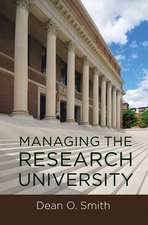Creating and Maintaining Safe College Campuses: A Sourcebook for Enhancing and Evaluating Safety Programs
Editat de Melvin Cleveland Terrell, Jerlando F. L. Jacksonen Limba Engleză Paperback – 4 apr 2007
Preț: 169.16 lei
Preț vechi: 325.82 lei
-48% Nou
Puncte Express: 254
Preț estimativ în valută:
32.37€ • 34.61$ • 26.99£
32.37€ • 34.61$ • 26.99£
Carte tipărită la comandă
Livrare economică 17 aprilie-01 mai
Preluare comenzi: 021 569.72.76
Specificații
ISBN-13: 9781579221966
ISBN-10: 1579221963
Pagini: 304
Dimensiuni: 152 x 229 x 15 mm
Greutate: 0.42 kg
Ediția:1
Editura: Taylor & Francis
Colecția Routledge
Locul publicării:Oxford, United Kingdom
ISBN-10: 1579221963
Pagini: 304
Dimensiuni: 152 x 229 x 15 mm
Greutate: 0.42 kg
Ediția:1
Editura: Taylor & Francis
Colecția Routledge
Locul publicării:Oxford, United Kingdom
Public țintă
Postgraduate and Professional Practice & DevelopmentCuprins
Introduction. The Complexity of Maintaining a Safe Campus in Higher Education. An Administrative Dilemma 1. Changing the Culture of High-Risk Drinking 2. Violence and Hate Crimes on Campus Against International Students and Students of Color. Uncovering the Mystique 3. Campus Climate for Sexual Minority Students. Challenges and Best Practices 4. Campus Safety Issues for Women 5. Why Do Students Beat Other Students? 6. The Role of the Campus Safety Department in the 21st Century 7. The Incompatibility of Weapons and College Campuses 8. Safety in a Community College Environment 9. Public Safety Issues at Minority-Serving Institutions 10. The Legal Implications of Campus Crime for Student Affairs Professionals 11. Exemplar Programs and Procedures. Best Practices in Public Safety 12. You’re Not Alone. Resources for the College Administrator 13. Elements of a Comprehensive Safety Plan
Notă biografică
Melvin Cleveland Terrell is Vice President Emeritus at Northeastern Illinois University in Chicago. From 1988 to 2008, Dr. Melvin Cleveland Terrell served as Vice President for Student Affairs at Northeastern Illinois University in Chicago, Illinois, where he remains Professor of Counselor Education. Jerlando F. L. Jackson is an Assistant Professor of Higher and Postsecondary Education in Educational Leadership and Policy Analysis, Faculty Associate for the Wisconsin Center for the Advancement of Postsecondary Education, and Faculty Affiliate in the Weinert Center for Entrepreneurship at the University of Wisconsin-Madison.
Recenzii
"The job of keeping campuses safe has become increasingly complicated in a diverse climate, and this book is meant to make sure college and university staff are up to the challenges. In the wake of the recent violence surrounding campus protests, this book offers timely advice on handling hate crimes and confronting discrimination on campus, as well as on other safety issues, such as binge drinking and sexual harassment. It offers perspectives on different types of institutions and provides guidelines for administrators, faculty and policy makers."
Diverse
"The authors and editors have approached this topic with a plan that seems to work for introducting the suprising array of concerns that impinge upon campus safety. Few stones are left unturned as they pursue this agenda, with adequate coverage of personal, institutional, and societal concerns. The readers comes away witha fairly clear sense of the problem and related issues, as well as sufficient suggestions for what to do about them....recommend that campus administrators place this on their desks sooner rather than later."
Journal of Higher Education
"[The] editors tackle the complex issues of safety at America's multiple and diverse college campuses. They note the significance of institutional type, location, and student composition in shaping the campus environment and the influence these factors have on developing a safe campus environment. This is an extraordinary undertaking (to address standards of safety while acknowledging and accounting for institutional difference), but the editors and respective authors of the 14 chapters of this work do justice to the task.
College administrators, especially those in student affairs, should rely on this work to stimulate their thinking about routine safety practices. Administrators should also refresh their thinking and renew their commitment to working as institutioinal officers with others across the campus charged with monitoring the well-being of the campus community."
Creating and Maintaining Safe College Campuses reminds its readers that safety is an evolving and complex dynamic. Efforts to insure personal safety must contemplate the complexity of each individual and the community at large. The editors and authors have done a superb job of reminding us of this and our campuses will be safer because of it."
The Journal of College Student Development
"Almost everyone knows about the hidden underbelly of campus life, but until now it had not been comprehensively examined from different perspectives. The contributors to this book do a great service by charting the territory and offering many sound ideas for ensuring student safety."
George D. Kuh, Ph.D., Chancellor’s Professor; Director of the Indiana University Center for Postsecondary Research
"Outstanding! This is the first word for the new book by Dr. Jerlando F.L. Jackson and Dr. Melvin Cleveland Terrell that consolidates the views of the best experts in America today, clearly and concisely stating the case for re-focusing efforts on creating and maintaining campus safety. The authors’ thorough discussions center on the most current data, issues, problems and concerns, making this a must-read for all stakeholders in higher education."
Larry D. Bolles, Director, Judicial Affairs, Northern Illinois University
"University and college leaders have an opportunity to use this tool to explore the important issues facing our campuses today. Depending on the circumstances, they can use the chapters that most apply to their situation in order to receive current information. In addition, this book frames the issues with great understanding of the complex nature of young adults, the campus environment, and the growing challenges of safety in America. It can serve as a great reference, the basis for discussion and action, while at the same time serving as a benchmarking tool all in one."
Susan Riseling, Associate Vice Chancellor/Police Chief, University of Wisconsin; Vice President at Large, International Association of Chiefs of Police
"Drs. Jackson and Terrell’s book provides college student educators and other stakeholders with a compelling list of reasons why creating and maintaining a safe campus is of paramount importance. This book not only frames the campus safety movement, but it also challenges us to look at our institutional cultures that sustain and support these negative behaviors. More importantly, this book provides its readers with the ideas and best practices to help campuses galvanize current resources and maximize the return on their future investments."
Jeanne S. Steffes, Associate Vice President of Student Affairs, Syracuse University; President, American College Personnel Association-College Student Educators International
"This book is an excellent source for higher education administrators in their quest to design safe college environments. Considering the numerous accountability issues facing higher education today, providing safe college campuses is an essential priority. The contributing authors of this book provide excellent advice and models on how to be accountable in preventing crime and violence on college and university campuses. I highly recommend this book for both student affairs and academic affairs administrators."
Cynthia Daniels Sellers, Executive Assistant to the President, Hampton University and Past Chair, National Association of Student Affairs Professionals
"This is a must read for campus leaders who wish to remain current with the ever-evolving field of campus safety. The editors have brought together some of the nation's foremost scholars and practitioners to advance inquiry regarding critical campus safety issues at a wide variety of institutions. This book is a must read for those leaders who wish to provide safe and nurturing environments for their students. Highly recommended!"
Michael S. Brophy, President, Marymount College
"Jackson, Terrell, and the contributing authors provide a thorough description and analysis of the problems and challenges associated with maintaining and enhancing safety on public, private, two-year or four-year college campuses. Strategies and best practices provide readers with actions that are adaptable to their campus environments and cultures. This book is beneficial to anyone regardless of hierarchical position or years of experience managing or responding to campus safety issues."
Kevin W. Bailey, Assistant Vice President for Student Affairs, Tulane University
"This book is an excellent source for higher education administrators in their quest to design safe college environments. Considering the numerous accountability issues facing higher education today, providing safe college campuses is an essential priority. The contributing authors of this book provide excellent advice and models on how to be accountable in preventing crime and violence on college and university campuses. I highly recommend this book for both student affairs and academic affairs administrators."
Cynthia Daniels Sellers, Executive Assistant to the President, Hampton University and Past Chair, National Association of Student Affairs Professionals
Diverse
"The authors and editors have approached this topic with a plan that seems to work for introducting the suprising array of concerns that impinge upon campus safety. Few stones are left unturned as they pursue this agenda, with adequate coverage of personal, institutional, and societal concerns. The readers comes away witha fairly clear sense of the problem and related issues, as well as sufficient suggestions for what to do about them....recommend that campus administrators place this on their desks sooner rather than later."
Journal of Higher Education
"[The] editors tackle the complex issues of safety at America's multiple and diverse college campuses. They note the significance of institutional type, location, and student composition in shaping the campus environment and the influence these factors have on developing a safe campus environment. This is an extraordinary undertaking (to address standards of safety while acknowledging and accounting for institutional difference), but the editors and respective authors of the 14 chapters of this work do justice to the task.
College administrators, especially those in student affairs, should rely on this work to stimulate their thinking about routine safety practices. Administrators should also refresh their thinking and renew their commitment to working as institutioinal officers with others across the campus charged with monitoring the well-being of the campus community."
Creating and Maintaining Safe College Campuses reminds its readers that safety is an evolving and complex dynamic. Efforts to insure personal safety must contemplate the complexity of each individual and the community at large. The editors and authors have done a superb job of reminding us of this and our campuses will be safer because of it."
The Journal of College Student Development
"Almost everyone knows about the hidden underbelly of campus life, but until now it had not been comprehensively examined from different perspectives. The contributors to this book do a great service by charting the territory and offering many sound ideas for ensuring student safety."
George D. Kuh, Ph.D., Chancellor’s Professor; Director of the Indiana University Center for Postsecondary Research
"Outstanding! This is the first word for the new book by Dr. Jerlando F.L. Jackson and Dr. Melvin Cleveland Terrell that consolidates the views of the best experts in America today, clearly and concisely stating the case for re-focusing efforts on creating and maintaining campus safety. The authors’ thorough discussions center on the most current data, issues, problems and concerns, making this a must-read for all stakeholders in higher education."
Larry D. Bolles, Director, Judicial Affairs, Northern Illinois University
"University and college leaders have an opportunity to use this tool to explore the important issues facing our campuses today. Depending on the circumstances, they can use the chapters that most apply to their situation in order to receive current information. In addition, this book frames the issues with great understanding of the complex nature of young adults, the campus environment, and the growing challenges of safety in America. It can serve as a great reference, the basis for discussion and action, while at the same time serving as a benchmarking tool all in one."
Susan Riseling, Associate Vice Chancellor/Police Chief, University of Wisconsin; Vice President at Large, International Association of Chiefs of Police
"Drs. Jackson and Terrell’s book provides college student educators and other stakeholders with a compelling list of reasons why creating and maintaining a safe campus is of paramount importance. This book not only frames the campus safety movement, but it also challenges us to look at our institutional cultures that sustain and support these negative behaviors. More importantly, this book provides its readers with the ideas and best practices to help campuses galvanize current resources and maximize the return on their future investments."
Jeanne S. Steffes, Associate Vice President of Student Affairs, Syracuse University; President, American College Personnel Association-College Student Educators International
"This book is an excellent source for higher education administrators in their quest to design safe college environments. Considering the numerous accountability issues facing higher education today, providing safe college campuses is an essential priority. The contributing authors of this book provide excellent advice and models on how to be accountable in preventing crime and violence on college and university campuses. I highly recommend this book for both student affairs and academic affairs administrators."
Cynthia Daniels Sellers, Executive Assistant to the President, Hampton University and Past Chair, National Association of Student Affairs Professionals
"This is a must read for campus leaders who wish to remain current with the ever-evolving field of campus safety. The editors have brought together some of the nation's foremost scholars and practitioners to advance inquiry regarding critical campus safety issues at a wide variety of institutions. This book is a must read for those leaders who wish to provide safe and nurturing environments for their students. Highly recommended!"
Michael S. Brophy, President, Marymount College
"Jackson, Terrell, and the contributing authors provide a thorough description and analysis of the problems and challenges associated with maintaining and enhancing safety on public, private, two-year or four-year college campuses. Strategies and best practices provide readers with actions that are adaptable to their campus environments and cultures. This book is beneficial to anyone regardless of hierarchical position or years of experience managing or responding to campus safety issues."
Kevin W. Bailey, Assistant Vice President for Student Affairs, Tulane University
"This book is an excellent source for higher education administrators in their quest to design safe college environments. Considering the numerous accountability issues facing higher education today, providing safe college campuses is an essential priority. The contributing authors of this book provide excellent advice and models on how to be accountable in preventing crime and violence on college and university campuses. I highly recommend this book for both student affairs and academic affairs administrators."
Cynthia Daniels Sellers, Executive Assistant to the President, Hampton University and Past Chair, National Association of Student Affairs Professionals
Descriere
This book serves as a sourcebook to enhance and evaluate safety programs, generate new solutions and interventions, comply with new legislation, and present practical steps and guidelines to establish best practices.

















